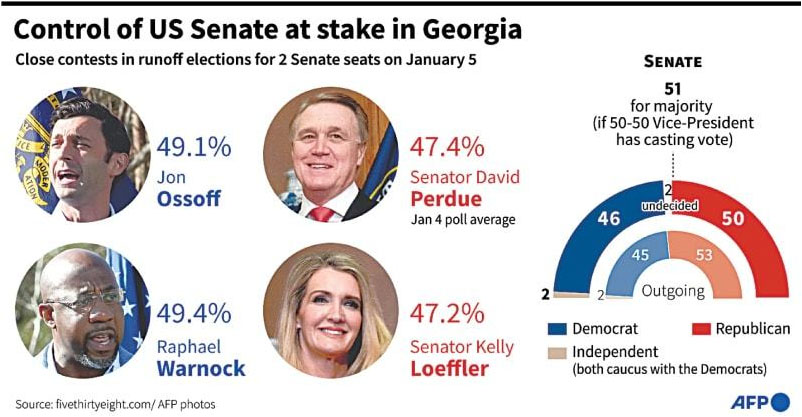Excellent study material for all civil services aspirants - begin learning - Kar ke dikhayenge!
U.S. PRESIDENTIAL ELECTIONS
Read more on - Polity | Economy | Schemes | S&T | Environment
- The US election system : The US system of electing a president is a two-step process. Step 1 is direct voting for the candidates who stand for the Presidency, and Step 2 is the voting by States' electoral colleges. The popular vote is not used to elect the President while it indeed consists of the total number or percentage of votes received by a party. The Electoral College is used to determine the winner of the national election. There have been five United States presidential elections in which the person who became president received fewer popular votes than their opponent, including Trump's election in 2016.
- What is the US Electoral College : It is a body of "electors", constituted every four years for the purpose of electing the president and vice president of the United States. It consists of 538 electors, and an absolute majority of 270 electoral votes is required to win an election.
- Established by the US Constitution : Pursuant to Article II, the legislature of each state determines the manner by which its electors are chosen. Each state's number of electors is equal to the combined total of the state's membership in the Senate and House of Representatives. As on date, there are 100 senators and 435 representatives. (The Twenty-third Amendment provides that the District of Columbia (D.C.) is entitled to a number of electors no greater than that of the least populous state (3)). So total votes = 100 + 435 + 3 = 538. To win, you need 270 votes.
- Popular vote happens, and then ... : Following the national presidential election day in the first week of November, each state counts its popular votes pursuant to that state's laws to designate presidential electors. State electors meet in their respective state capitals in December and cast their votes.
- Tabulation of results : The results are certified by the states and D.C. to Congress, where they are tabulated nationally in the first week of January before a joint meeting of the Senate and House of Representatives. The elected president and vice president are inaugurated on January 20. While the electoral vote has given the same result as the popular vote in most elections, this has not been the case in a few elections, including the 2000 and 2016 elections!
- Fifth time unlucky : Candidate Hillary Clinton became the fifth presidential candidate in US to lose the election despite winning the popular vote.
- Each state is worth a set number of electoral college votes. In most states, the winner of the popular ballot gets all that state’s electoral college votes (unless members of the electoral college choose not to vote for them).
- There are currently 538 available electoral college votes. The would-be president needs to secure 270 of these to win. Despite being ahead in the popular vote, Hillary was stuck at lower electoral college votes.
- The Bush election : The last time the electoral applecart was upset in this fashion was in 2000. In controversial circumstances George W Bush took Florida, allowing him to reach the 270 vote target – just. He secured 271 electoral college votes to Al Gore’s 266 (one elector abstained from casting an electoral vote for the latter).
- Trump's story : Trump won the Electoral College by achieving narrow wins in several large states that had previously voted for President Obama, including Florida, Pennsylvania and Ohio. Clinton ran ahead of him in the popular vote by running up much larger margins in states like New York and California.
- Historically : Prior to that election, it had been 112 years since another Republican candidate, Benjamin Harrison, secured a majority of electoral college ballots while losing the popular vote.
- It was (yet another) Republican who this system first advantaged in 1876: Rutherford B Hayes won out by just one electoral college vote, despite more than 250,000 fewer ballots being cast for him than his main opponent, Samuel J Tilden.
- Arguably the strangest happening of all, however, was in 1824, when John Quincy Adams won the presidency even though Andrew Jackson had received more popular votes and more electoral votes. Because none of the candidates in the race reached the required number of electoral college votes, the decision was left to the House of Representatives, which opted for Adams.
- A problem : Some say that the electoral college is a disaster for the democracy. To change the system will require an amendment to the U.S. Constitution, a slow and difficult process requiring large majorities in Congress and among the individual states. Those who win have no incentive to change the system!
- Why have the Electoral College at all? The Electoral College was created by the country's founding fathers for a variety of reasons.
- The Constitution's 18th century framers, seeking to meld a number of independent former colonies into a single nation, shunned a direct popular election because of a "fear of mob rule."
- They also worried that, before the age of mass communication and easy transportation, citizens would not know much about candidates living in distant states.
- Smaller states, especially in the agrarian South, also worried about being overwhelmed by more populous northern states. To this day, the Electoral College formula tilts the scales in favor of less densely populated rural states, where the Republican Party currently enjoys its strongest support.
- All of the motivations are irrelevant, but still the system exists!
* Content sourced from free internet sources (publications, PIB site, international sites, etc.). Take your own subscriptions. Copyrights acknowledged.





















COMMENTS